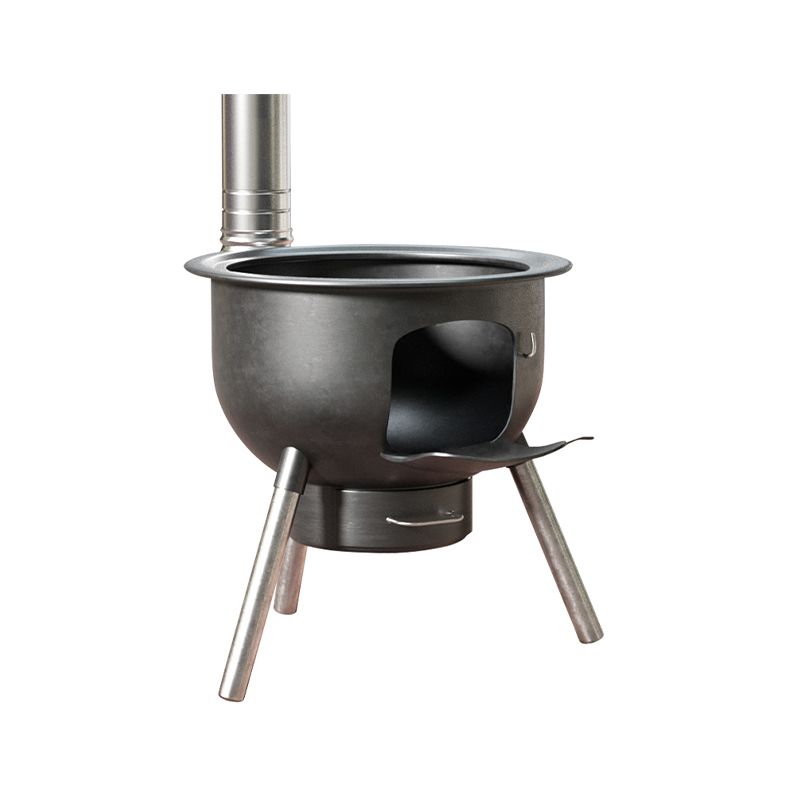How does the mesh density of a barbecue stove affect the evenness of food heating?
Release Time : 2025-11-19
The mesh density of a barbecue stove is a key factor affecting the evenness of food heating. Its design must balance heat transfer efficiency, airflow, and food compatibility. A mesh that is too sparse or too dense can lead to localized overheating, scorching, or uncooking. A well-designed mesh density optimizes heat transfer paths and airflow distribution, ensuring even heating of the food.
The mesh density of a barbecue stove directly impacts heat transfer efficiency. When the mesh spacing is large, the contact area between the food and the grill is reduced, requiring heat to travel a longer path from the grill to the food. This design can cause the surface of thick cuts of food (such as a whole steak) to char quickly while the inside remains uncooked, resulting in a "burnt outside, raw inside" appearance. Conversely, if the mesh is too dense, the food may completely cover the mesh, hindering direct heat transfer from the grill below and relying instead on convection from the surrounding air. If airflow is poor, the bottom of the food is prone to charring due to heat buildup, especially when using charcoal grilling. A dense mesh can restrict direct contact between the charcoal and the food, further reducing heat transfer efficiency.
Airflow is another key consideration in grid density design. A suitable grid density creates uniform airflow channels, allowing hot air to circulate over the food surface and preventing localized overheating. For example, when grilling chicken wings or vegetables, a moderate grid spacing allows hot air to penetrate the gaps between the ingredients, removing surface moisture and creating a crispy crust. If the grid is too dense, airflow is obstructed, and "heat trapping zones" easily form on the food surface, preventing localized moisture evaporation and causing the food to become soggy or sticky. Conversely, if the grid is too sparse, some areas of the food may be exposed to strong airflow, accelerating moisture loss and resulting in a dry and hard texture.
The type and shape of the food also present different requirements for grid density. When grilling skewers (such as lamb skewers), a grill rack with a grid spacing slightly larger than the diameter of the food should be chosen. This prevents the food from getting stuck in the grid and ensures that heat penetrates evenly from multiple directions. If the grid is too dense, the skewers may be difficult to insert or rotate, increasing the difficulty of handling; if it is too sparse, the food may sink due to gravity, resulting in uneven heating. For flat ingredients (such as fish fillets or tofu), a denser mesh provides more stable support, preventing breakage when flipping. It also distributes pressure through multiple points of contact, reducing the risk of food sticking to the grill.
The mesh density of a barbecue stove is also closely related to the thermal conductivity of the grill material. Stainless steel grills, due to their superior thermal conductivity compared to galvanized iron grills, can transfer heat to food more quickly at the same mesh density. In this case, a denser mesh can further improve heat transfer efficiency and shorten cooking time. Materials with poor thermal conductivity require wider mesh spacing to reduce heat transfer resistance and prevent localized overheating. For example, cast iron grills, due to their high heat retention capacity, often use a more sparse mesh design, utilizing their slow-release heat to achieve even heating.
Modern barbecue stoves optimize mesh density and heat uniformity through innovative design. Some high-end models feature adjustable mesh grills, allowing users to flexibly adjust the spacing according to the type of food, achieving "one grill for multiple uses." For example, when grilling a whole chicken, the spacing can be increased to accommodate the chicken body, while the spacing can be decreased to prevent shrimp from slipping. Another type of grill uses a wavy mesh design, increasing the number of contact points to improve heat transfer efficiency, while the curved surface guides airflow, creating a three-dimensional heating effect.
Ease of cleaning and maintenance is also a crucial consideration in mesh density design. Dense meshes easily trap food residue and grease, increasing cleaning difficulty; while sparse meshes may allow residue to embed inside the grill due to large gaps. Therefore, mainstream designs often use medium-density meshes, combined with a non-stick coating or a removable structure, ensuring both even heat distribution and easy daily maintenance.
From a cooking experience perspective, a suitable mesh density significantly improves operational efficiency and product quality. Evenly heated food doesn't require frequent flipping, reducing interference during grilling and allowing the cook to focus more on heat control and seasoning. Simultaneously, uniform caramelization enhances the aroma compounds in the food, resulting in a more appealing color and texture, satisfying consumers' desire for a smoky flavor.




